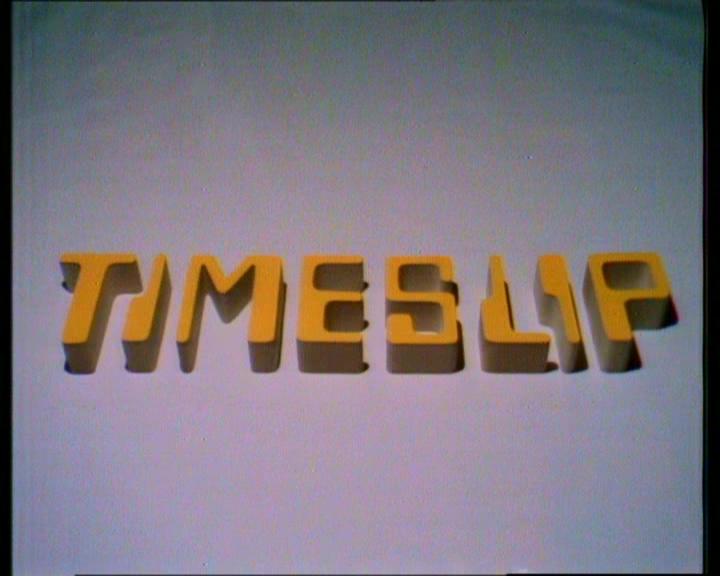Timeslip (lost color negatives of British children's TV series; 1970): Difference between revisions
No edit summary |
No edit summary |
||
| (9 intermediate revisions by 3 users not shown) | |||
| Line 1: | Line 1: | ||
{{InfoboxLost | |||
|title=<center>Timeslip (color negatives)</center> | |||
''''' | |image=Timeslip.jpg | ||
|imagecaption=''Timeslip'' title card from the only surviving color episode. | |||
|status=<span style="color:red;">'''Lost'''</span> | |||
}} | |||
''Timeslip'' was a British children's science fiction television series made by ATV for the ITV network and broadcast between 1970 and 1971. The show centered around two children, Simon Randall and Liz Banks, who discovers a strange anomaly, known as the "Time Barrier", which allows them to travel in time to different historical periods in alternate pasts and futures. | |||
The series was originally recorded on color tapes, excluding episodes 23 and 24, which were recorded in black and white due to the 1970 ITV "Colour Strike". The episodes now only exist in black and white, presumably copies of the original tapes. Only one episode survives in its original color; the final of the 6 part | The series was originally recorded on '''color tapes''', excluding episodes 23 and 24, which were recorded in black and white due to the 1970 ITV "Colour Strike". The episodes now only exist in black and white, presumably copies of the original tapes. Only one episode survives in its original color; the final episode of the 6-part arc "The Time of the Ice Box". VHS releases in the 1990s would have this episode in black and white; out of uniformity, however, it is kept in color on DVD releases. | ||
It is believed that the episodes' original color master tapes were wiped and re-used by ITV Central in the 1980s after they took over from ATV, providing ITV | It is believed that the episodes' original color master tapes were wiped and re-used by ITV Central in the 1980s after they took over from ATV, providing ITV programs to the Midlands. At the time, these programs were seen to have no commercial value and were deemed worthless, the concept of videotapes and DVD releases were, needless to say, not a consideration. Other sources state the master tapes survived but were very badly damaged due to insufficient storage conditions. | ||
Certain people online have attempted to colorize the series as a replacement to having the original color negatives, though no professional efforts seem to have been done for any releases. Incidentally, colorizations of the title cards can be seen on the official website for the series.<ref>[http://www.timeslip.org.uk/episodeguide/index.php ''Timeslip'' episode guide, courtesy of timeslip.org.uk, the series' official website.] Retrieved 20 May '14 | Certain people online have attempted to colorize the series as a replacement to having the original color negatives, though no professional efforts seem to have been done for any releases. Incidentally, colorizations of the title cards can be seen on the official website for the series.<ref>[http://www.timeslip.org.uk/episodeguide/index.php ''Timeslip'' episode guide, courtesy of timeslip.org.uk, the series' official website.] Retrieved 20 May '14</ref> | ||
== | ==Gallery== | ||
{{Video|perrow =1 | |||
|service1 =youtube | |||
|id1 =9eOt1ZlFh2c | |||
|description1 =Black and white introduction by Peter Fairley to the first episode. | |||
}} | |||
==Reference== | |||
{{reflist}} | |||
[[Category:Lost TV]] | |||
[[Category:Completely lost media]] | |||
Latest revision as of 14:54, 10 May 2020
Timeslip was a British children's science fiction television series made by ATV for the ITV network and broadcast between 1970 and 1971. The show centered around two children, Simon Randall and Liz Banks, who discovers a strange anomaly, known as the "Time Barrier", which allows them to travel in time to different historical periods in alternate pasts and futures.
The series was originally recorded on color tapes, excluding episodes 23 and 24, which were recorded in black and white due to the 1970 ITV "Colour Strike". The episodes now only exist in black and white, presumably copies of the original tapes. Only one episode survives in its original color; the final episode of the 6-part arc "The Time of the Ice Box". VHS releases in the 1990s would have this episode in black and white; out of uniformity, however, it is kept in color on DVD releases.
It is believed that the episodes' original color master tapes were wiped and re-used by ITV Central in the 1980s after they took over from ATV, providing ITV programs to the Midlands. At the time, these programs were seen to have no commercial value and were deemed worthless, the concept of videotapes and DVD releases were, needless to say, not a consideration. Other sources state the master tapes survived but were very badly damaged due to insufficient storage conditions.
Certain people online have attempted to colorize the series as a replacement to having the original color negatives, though no professional efforts seem to have been done for any releases. Incidentally, colorizations of the title cards can be seen on the official website for the series.[1]
Gallery
Reference
- ↑ Timeslip episode guide, courtesy of timeslip.org.uk, the series' official website. Retrieved 20 May '14
